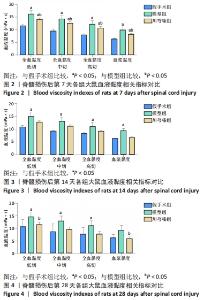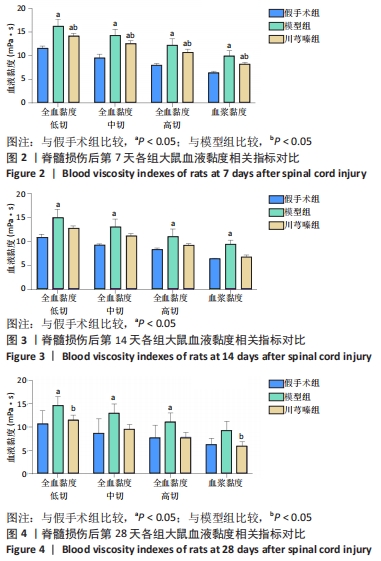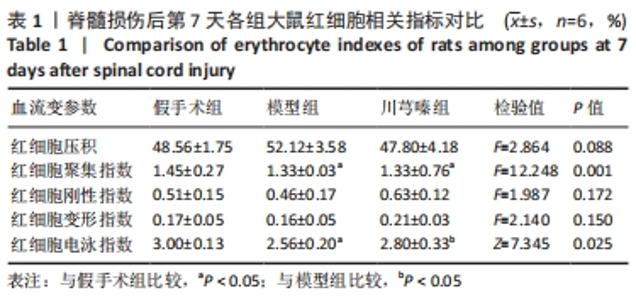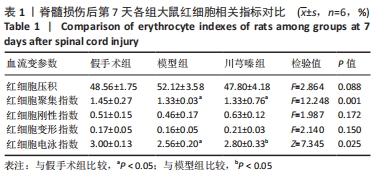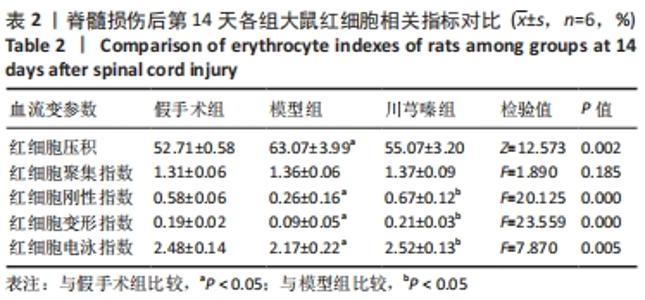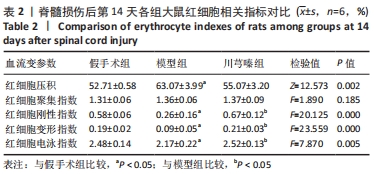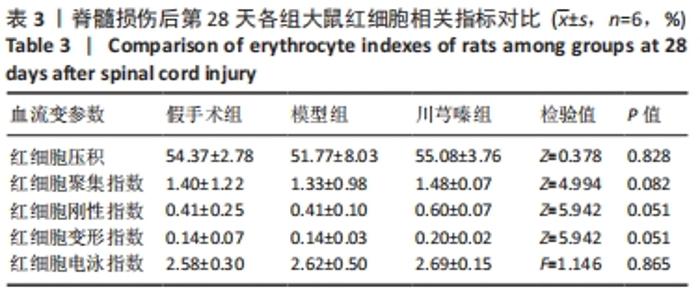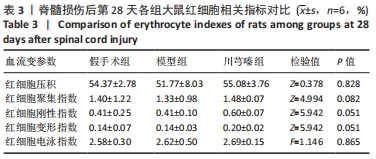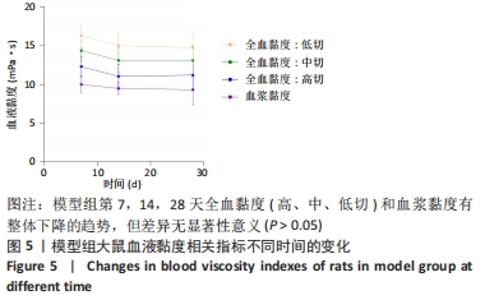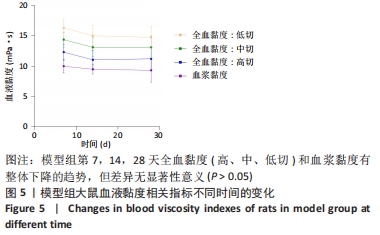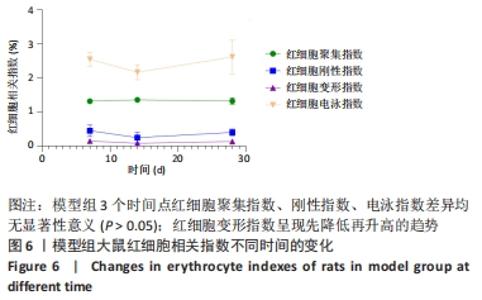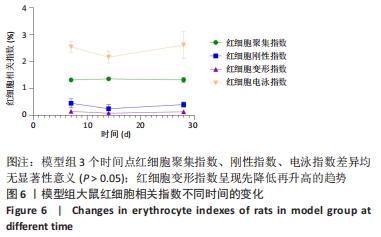[1] KARSY M, HAWRYLUK G. Modern Medical Management of Spinal Cord Injury. Curr Neurol Neurosci Rep. 2019;19(9):65.
[2] KUMAR R, LIM J, MEKARY RA, et al. Traumatic Spinal Injury: Global Epidemiology and Worldwide Volume. World Neurosurg. 2018;113:e345-e363.
[3] LI X, LUO D, HOU Y, et al. Sodium Tanshinone IIA Silate Exerts Microcirculation Protective Effects against Spinal Cord Injury In Vitro and In Vivo. Oxid Med Cell Longev. 2020;2020:3949575.
[4] YUAN X, WU Q, TANG Y, et al. Systemic microcirculation dysfunction after low thoracic spinal cord injury in mice. Life Sci. 2019;221:47-55.
[5] 齐英娜,王威,吴鑫杰,等.脊髓损伤后微循环的变化及微循环障碍的药物治疗进展[J].中医正骨,2017,29(10):47-49.
[6] 徐春林,黄伟,冯石萍.脊髓损伤患者手术前后大脑血流指标及血流变的变化规律研究[J].海南医学院学报,2013,19(1):41-43+46.
[7] 陈博,林勋,詹红生,等.温阳通督中药结合理筋手法对颈脊髓机械性压迫损伤家兔模型血液流变学的影响[J].上海中医药大学学报,2011,25(1):49-52.
[8] 韩炜.川芎的化学成分与药理作用研究进展[J].中国现代中药,2017,19(9): 1341-1349.
[9] 李东哲.川芎嗪对大鼠急性脊髓损伤后微血管及胶原成分的影响[D].长沙:中南大学,2014.
[10] WANG C, WANG P, ZENG W, et al. Tetramethylpyrazine improves the recovery of spinal cord injury via Akt/Nrf2/HO-1 pathway. Bioorg Med Chem Lett. 2016; 26(4):1287-1291.
[11] SHIN JW, MOON JY, SEONG JW, et al. Effects of tetramethylpyrazine on microglia activation in spinal cord compression injury of mice. Am J Chin Med. 2013;41(6):1361-1376.
[12] 蒋昇源,邓博文,徐林,等.川芎嗪修复脊髓损伤的作用及机制[J].中国组织工程研究,2022,26(11):1886-1892.
[13] 贺丰,俞兴,穆晓红,等.新型脊髓完全横断缺损模型大鼠的建立[J].中国组织工程研究,2016,20(5):635-639.
[14] HU J, CAO Y, WU T, et al. Micro-CT as a Tool to Investigate the Efficacy of Tetramethylpyrazine in a Rat Spinal Cord Injury Model. Spine. 2016;41(16):1272-1278.
[15] ASHAMMAKHI N, KIM HJ, EHSANIPOUR A, et al. Regenerative Therapies for Spinal Cord Injury. Tissue Eng Part B Rev. 2019;25(6):471-491.
[16] COWAN H, LAKRA C, DESAI M. Autonomic dysreflexia in spinal cord injury. BMJ. 2020;371:m3596.
[17] HU XC, LU YB, YANG YN, et al. Progress in clinical trials of cell transplantation for the treatment of spinal cord injury: how many questions remain unanswered? Neural Regen Res. 2021;16(3):405-413.
[18] ALIZADEH A, DYCK SM, KARIMI-ABDOLREZAEE S. Traumatic Spinal Cord Injury: An Overview of Pathophysiology, Models and Acute Injury Mechanisms. Front Neurol. 2019;10:282.
[19] TRAN AP, WARREN PM, SILVER J. The Biology of Regeneration Failure and Success After Spinal Cord Injury. Physiol Rev. 2018;98(2):881-917.
[20] FAN B, WEI Z, YAO X, et al. Microenvironment Imbalance of Spinal Cord Injury. Cell Transplant. 2018;27(6):853-866.
[21] 谭荣镑,魏波,李广盛.Nrf2-ARE调控神经-血管交互作用参与脊髓损伤后的神经修复[J].中国组织工程研究,2021,25(35):5694-5701.
[22] DUAN YY, CHAI Y, ZHANG NL, et al. Microtubule Stabilization Promotes Microcirculation Reconstruction After Spinal Cord Injury. J Mol Neurosci. 2021; 71(3):583-595.
[23] 张俐,安国尧,张文光,等.丹参酮-ⅡA磺酸钠对脊髓缺血再灌注损伤NF-κB、VCAM-1和血液流变性的影响[J].中国骨伤,2012,25(12):1016-1020.
[24] 齐英娜,王延雷,吴鑫杰,等.改进球囊导管法构建大鼠急性压迫型上颈脊髓损伤模型及模型大鼠伤后早期血液流变学指标观察[J].中医正骨,2017, 29(11):26-32.
[25] HU JZ, WANG XK, CAO Y, et al. Tetramethylpyrazine Facilitates Functional Recovery after Spinal Cord Injury by Inhibiting MMP2, MMP9, and Vascular Endothelial Cell Apoptosis. Curr Neurovasc Res. 2017;14(2):110-116.
[26] 刘剑刚,史大卓.影响血液流变学的活血化瘀中药药物研究[J].中国血液流变学杂志,2004,14(1):133-137.
|
